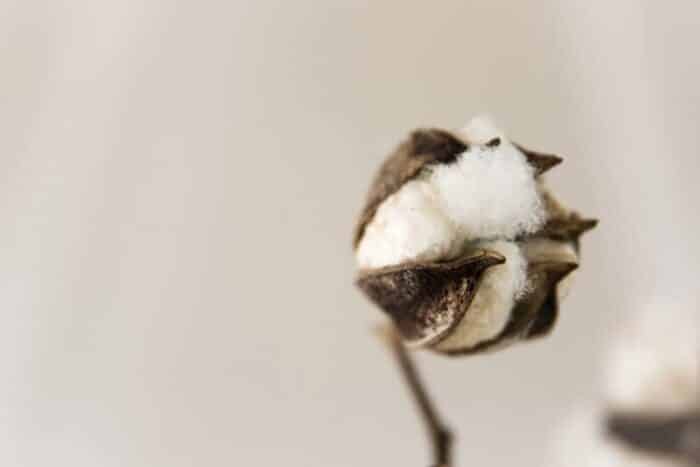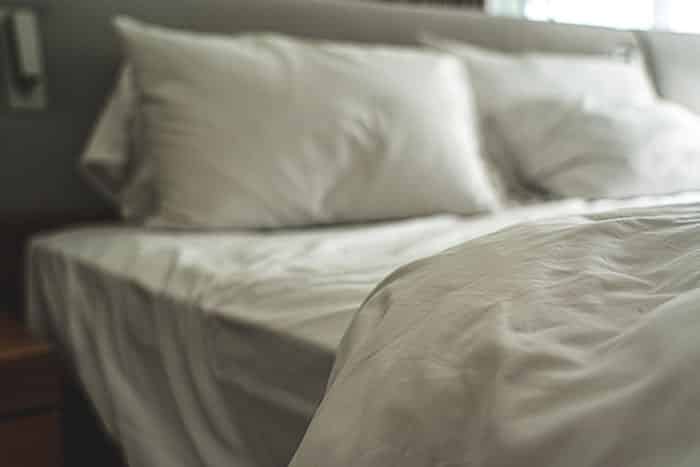The quality and feel of your bed sheets may impact your sleep and overall comfort. For example, some fabrics have a rough texture and can irritate your skin, whereas others can trap in sweat.
Cotton is generally a good choice but can have different weaves, textures, and thread counts. Two popular options, percale and sateen, are made from cotton fibers. Yet, one has a crisp, cool feel and a matte appearance, while the other is silky smooth, with a shiny finish.

When it comes to percale vs. sateen, you’ll want to factor in their breathability, durability, texture, and price, among other aspects. Here’s what you know about these types of cotton weaves.
In This Guide
Differences | Pros & Cons of Percale | Pros & Cons of Sateen | Summary
What’s the Difference between Percale and Sateen?
The terms “sateen” and “percale” refer to how the fabric is woven. Simply put, these are weaving techniques used to make sheets, pillowcases, and other bed linens.

- Percale sheets are usually made of cotton. The yarns are woven over and under each other, resulting in a crisp feel and increased durability.
- Sateen sheets are made of cotton, too, but the yarns are woven in a pattern where three or four threads go over one thread. This gives the fabric its distinctive smooth finish and luxurious sheen.
With either option, you can opt for 100% cotton or a blend of cotton and other fabrics, such as polyester. For example, some manufacturers combine cotton with rayon, nylon, or silk to make sateen sheets, scarves, and other products.
Pros and Cons of Percale Sheets
Percale feels like a freshly ironed shirt. It’s lightweight, breathable, and crisp, bringing a smooth aesthetic to your bedroom.
Another advantage is its durability and low maintenance. Percale sheets can last three to five years or longer due to their tight weave. Plus, they’re less prone to pilling than other types of sheets and can withstand frequent washing.

Their weave is cool to the touch, which makes them suitable for hot sleepers and people living in warmer climates. At the same time, they have a snug feel to them, keeping you comfortable during sleep.
A potential drawback is their susceptibility to wrinkling. Percale sheets are easy to wash and care for but require regular ironing.
Apart from that, they tend to cost more than other types of sheets, with the price being around $70 to $150. What you’ll pay depends on their composition, size, thread count, and brand. However, their durability and longevity may offset the initial investment.
Pros
- Lightweight and breathable
- Hypoallergenic
- Cool to the touch
- Durable and easy to care for
- Suitable for hot sleepers
- Tend to soften with every wash
- Have a crisp feel to them
- Maintain their quality over time
- Less prone to pilling than other fabrics
Cons
- Can feel stiff and scratchy at first
- May shrink slightly after the first wash
- Prone to wrinkles and creases
- Have a higher price tag than other fabrics
While this fabric may also feel “stiff” when new, it gets softer with every wash. You just need to give it some time.
Pros and Cons of Sateen Sheets
With its smooth surface and subtle shine, sateen can be a good choice for pillowcases and bed sheets. Just like percale, this weave is durable and has a luxurious feel to it.
But while sateen sheets are softer and silkier than percale sheets, they also tend to feel heavier. Plus, they’re less breathable and more likely to pill and retain heat. Though you may use them year-round, you may find them too warm on the hot summer days.

Sateen is prized for its resemblance to silk. It’s super smooth and drapes well, offering a cozy sensation throughout the night.
As far as pricing goes, sateen bed sheets tend to cost slightly more than percale sheets due to their higher thread count. You can get a high-quality set for less than $100, though some models can go over $200. Again, it all comes down to their brand, composition, and other factors.
Pros
- Smooth and silky, with a subtle sheen
- Have a heavier drape and retain more warmth than percale sheets
- Suitable for cold sleepers and people with sensitive skin
- Durable and easy to maintain
- Resistant to wrinkles and piling
- Remain soft over time
Cons
- Tend to bunch up due to their slippery finish
- May develop wrinkles and piling over time
- Their sheen may fade after repeated washes
- Less breathable than percale
- May feel too thick and heavy
- Can shrink if washed with hot water
Note that sateen sheets are wrinkle-resistant and less prone to pilling than percale sheets. However, they may develop creases and piling over time.
Percale vs. Sateen: Which Weave Is Right for You?
Sateen has a luxurious, silky feel and subtle sheen that can give your bed a polished look. Percale, on the other hand, feels lightweight and crisp and has a matte finish that fits into any bedroom.
Choosing between the two is a matter of personal preference. For example, not everyone enjoys the crisp feel of percale, and some people prefer silky fabrics like sateen, bamboo, or charmeuse.

As far as durability goes, both sateen and percale sheets can last for years. However, sateen is slightly more prone to wear and tear. Its sheen can fade over time, and the fabric can develop pilling and snagging, especially with improper care.
Our advice is to choose sateen sheets if:
- You want a luxurious feel
- You tend to get cold during sleep
- You enjoy the buttery-soft feel of sateen
- You’re looking for bed sheets that don’t require regular ironing
Percale sheets, on the other hand, might be a better option for those who:
- Tend to sleep hot
- Prefer the light, crisp feel of percale
- Want long-lasting sheets
- Live in a warmer climate
Lastly, note that both types of sheets can vary in quality. Our recommendation is to choose a thread count of 300 to 600 for sateen bed sheets or 200 to 400 for percale weave sheets.
If you’re ready to splurge a little, look for sateen or percale sheets made from Egyptian or Pima cotton. Sea Island cotton is an excellent choice, too. These fabrics are soft, smooth, and luxurious, blending durability and aesthetics.



